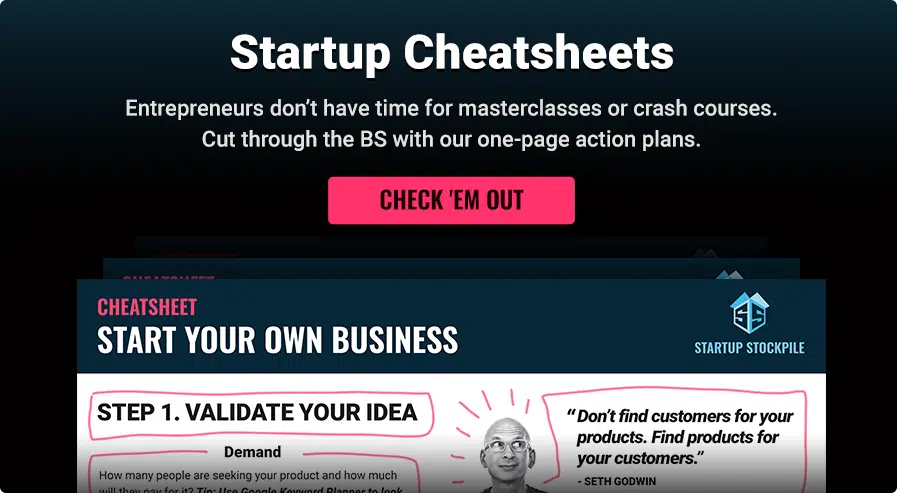How do you compete against well-established competitors with bigger budgets and virtually unlimited resources?
Focus on marketing channels where it’s not about how much you spend, it’s all about the work you put into it.
Marketing doesn’t have to be expensive in order for it to be effective. There are several low-cost marketing strategies that can help you outmaneuver even the best-funded competitors.
Even for startups on a shoestring budget, if you’re willing to be a little creative and focus on execution, there are areas where you can level the playing field and succeed.
With that in mind, here are half a dozen cheap marketing ideas you can use to compete with larger competitors:
1. Use Social Proof
One of the biggest hurdles new businesses have to overcome is credibility concerns. When you’re a new business you don’t have a long track record or existing customer base to point to. New customers need proof they can trust you.
How do you build trust?
You need social proof, and it’s basic buyer psychology.
Social proof is when customers recommend your products and services based on their experiences and people see those recommendations as proof they can trust your business. Examples include praise on social media, positive ratings on review sites, and customer testimonials.
So what does this mean for you tactically? Get your customers to review you online. Every time you have a happy customer ask them if they would be willing to give your business a review. Send them a quick email or text with a link to whatever review site you want to build reviews on.
Don’t want to do this manually? Use a tool like GatherUp to automate the process.
Building a robust online presence with loads of social proof will not only provide your business with credibility, but you’ll also start to attract more customers across the web. It takes some work but it’s totally worth it (and you can do it on the cheap).
2. Target Your Customers On Social Media
Advertising on social media can either be a gigantic waste of money or one of the cheapest marketing/highest ROI tactics you do.
The key is to understand which social media site is right for your customers.
If you’re a B2B company it might be LinkedIn. If you’re B2C you might want to try Facebook. If you’re targeting young people you might try Instagram or Snapchat
Once you’ve figured out where your customer is you need to run highly targeted ads. The better you are at targeting, the bigger the ROI.
These resources are can help:
- How to Target Local Customers With Facebook Ads
- 10 Ways to Generate More Leads and Referrals on LinkedIn
- How to Research an Instagram Target Audience
- The Ultimate Guide to Snapchat Marketing
You can also use social media to boost visibility, presence, and awareness about their company. However, simply having a presence on a social network won’t miraculously give you an advantage. You have to build it up.
Startups should start building a presence on social media even before they actually have a product designed. Use social media to tell your story online and connect with people in your industry.
Interact with them. Like, follow, share, and comment on their posts.
If you invest time in connecting with influencers in your industry and establish a meaningful relationship with them, you’ll have a consumer base familiar and interested in your product by the time you get it ready for sales.
Don’t wait until your product launches – start using social media to tell your story and building relationships now.
3. Solve a Niche Problem
There are over 3 billion Internet users in the world today and most of them are consumers looking to solve a problem. If you can find a unique problem and develop a solution, you won’t have to spend a dime on marketing.
That’s because niche-specific consumers will promote your product for you.
This doesn’t mean you need to invest in developing an entirely new product. Instead, you could add product features that serve niche-specific needs.
Big companies don’t bother with niches. They place a product on the market and niche customers buy it because they have no alternative.
By presenting those consumers with a product that serves them specifically, you have an entire consumer base ready to come over to your side, and that is a major advantage if there ever was one.
4. Do SEO & Content Marketing
Search engine optimization (SEO) should be part of your content marketing strategy. And your content marketing strategy should be simple: Produce useful content for your target customers then optimize that content so it has the best chance of ranking.
But don’t stress out. Google’s ranking algorithms are smart. It doesn’t matter how big your budget is, if you create useful content Google will send you traffic.
Mastering SEO and content marketing, in general, is one of the most cost-efficient ways to drive sales.
Don’t know where to start?
Here are 7 free resources you can start with:
- 7 Content Marketing Questions Answered For Startups and Entrepreneurs
- Content Marketing for Startups — Step-by-step Guide
- How 7 Startups Skyrocketed to Success with Content Marketing
- The 40-Point SEO Checklist for Startups
- A Startup’s Guide to Building a Content Marketing Strategy
- The Beginner’s Guide to Mastering SEO for Your Startup
- SEO for Startups – 5 Ways to Use Brains Over Budget
Pro Tip: Create competitor comparison pages for all your major competitors in your space. If the page is useful, it’s the easiest way to tap into qualified traffic and steal customers away from the competition.
5. Spread The Love
If there’s a time to crush the competition and get an advantage, it’s the holiday season. During the holiday season, consumers get excited and are willing to spend.
They’re also looking for the most appealing offer they can find. Being able to grab people’s attention can mean the difference between gaining an advantage or falling behind.
But instead of running a crazy sale or promoting your own products.
Show a little love to your customers during the holiday season by sending them a freebie, such as Christmas gift cards as a small thank you for being your customer.
You’ll find that giving a few bucks away cost less than running an expensive ad, and the ROI is better.
Even small customer gift ideas will keep your company top-of-mind during the holidays and boost word-of-mouth.
It’s the best referral marketing dollars you can spend.
6. Go Offline
In the world where the digital noise can be too much to bear, going offline can prove to be a gold mine. Experts argue that traditional marketing is dead and that debate is ongoing since 1994.
Today, traditional marketing is still alive and kicking, proving to be as efficient as it ever was. Modern consumers are constantly bombarded by offers and promotions via digital channels.
Most businesses have forgotten about traditional means altogether.
This can present a unique opportunity as not every consumer is online constantly. You can come up with cheap ways to give offline consumers a nudge in the right direction.
A well-placed newspaper or magazine ad, a billboard commercial or direct mail with the right message are all excellent traditional ways to get consumers interested.
With the right mix of digital and traditional marketing, your business can gain a significant advantage over competitors, leaving them in the dust.
Need some help coming up with ideas?
Here’s a quick list of cheap traditional marketing tactics:
- Invest in good quality business cards for all staff
- Sponsor a local sports team
- Go to a free networking event using Meetup
- Cold call
- Enter relevant awards for your industry and location
- Leave swag at key locations
- Speak at events
- Offer cross-promotions with businesses sharing the same target customers
Now Over To You
Start with these simple marketing ideas but keep your eyes open for new cost-effective strategies. Look for other customer acquisition channels where it’s not about how much money you spend.
Whether it’s a traditional or digital marketing opportunity, stay scrappy. Sprinkle in a little creativity and elbow grease, and focus on execution.
Remember startups by design are more nibble than big companies, so use that to your advantage. Treat every customer like gold even if you have to do things that don’t scale. If you do that, you’ll start to grow.
Editor’s Note: The article is part of the blog series Grow Your Business brought to you by the marketing team at UniTel Voice, the virtual phone system priced and designed for startups and small business owners.






